Identification, Characterization, and Deposit Model of Calcite Mineralization in the Middle Atlas Belts, Morocco
Abstract
1. Introduction
2. Geological Setting
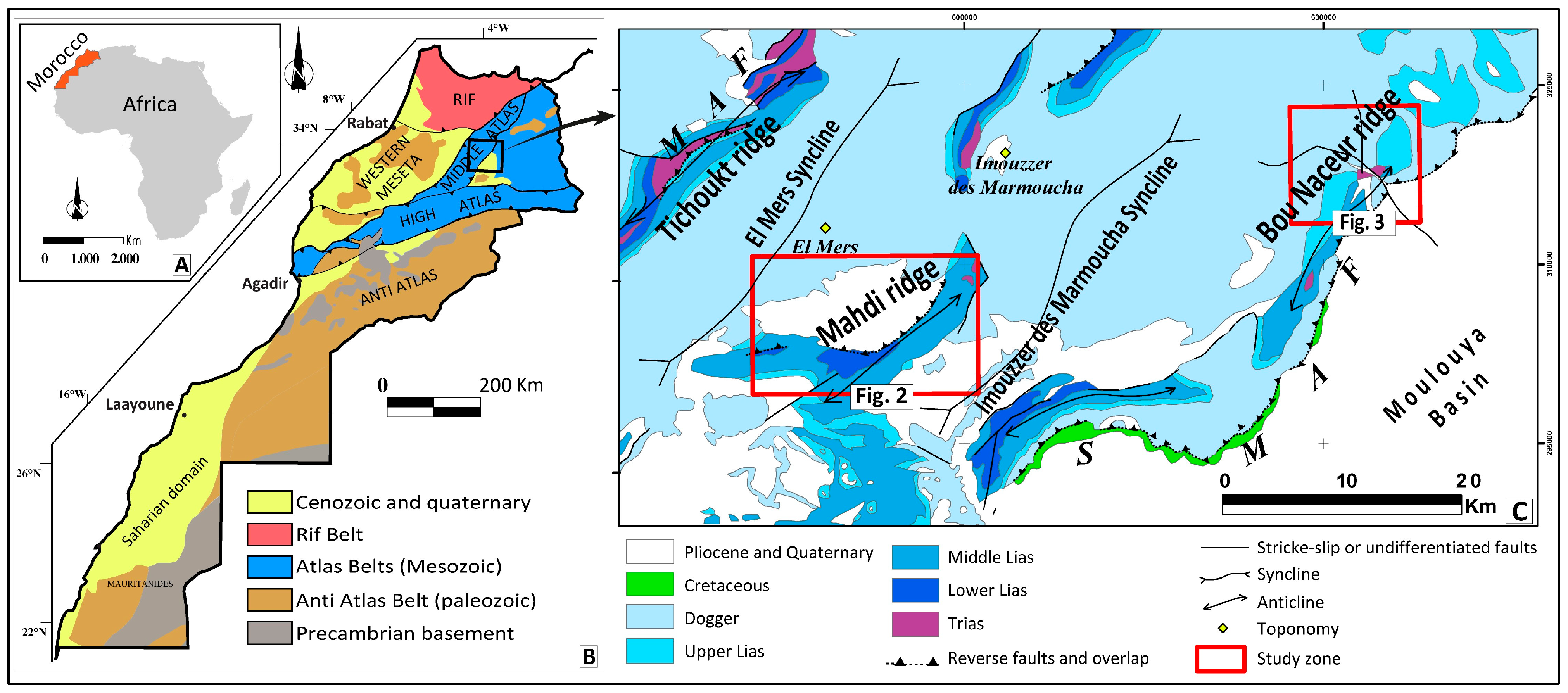
3. Methodology
4. Results
4.1. Mahdi Ridge: Calcite Vein System
4.1.1. Structural Study
4.1.2. Ore Morphology and Calcite Textures
4.1.3. Geochemical Analysis
4.2. Bou Nacer Ridge: Calcite Vein System
4.2.1. Structural Study
4.2.2. Ore Morphology and Calcite Textures
4.2.3. Geochemical Analysis
5. Discussion
6. Conclusions
Author Contributions
Funding
Data Availability Statement
Acknowledgments
Conflicts of Interest
References
- Pozo, M.; Casas, J.; Medina, J.A.; Calvo, J.P.; Silva, P.G. Caracterización de depósitos carbonáticos ligados a paleosurgencias en el sector de Batallones-Malcovadeso (Neógeno de la Cuenca de Madrid). Estud. Geológicos 2006, 62, 73–88. [Google Scholar] [CrossRef]
- Haldar, S.K. Minerals and rocks. In Introduction to Mineralogy and Petrology, 2nd ed.; Elsevier: Amsterdam, The Netherlands, 2020; pp. 1–51. ISBN 978-0-12-820585-3. [Google Scholar] [CrossRef]
- Dick, J.S.; Rader, C.P. Raw Materials Supply Chain for Rubber Products: Overview of the Global Use of Raw Materials, Polymers, Compounding Ingredients, and Chemical Intermediates; Hanser: Munich, Germany, 2014. [Google Scholar]
- Christian, T.; Brigitte, P.; Marie-Line, T.; Réal, D.; Bernard, L. Calcite Mineral Information Sheet. Available online: https://cerm.uqac.ca/trcm/wp-content/uploads/sites/4/2021/05/FI_07_Calcite.pdf (accessed on 12 June 2023).
- Ray, E. Harris Geology and Economic Potential of a High Calcium Limestone and Dolomitic Limestone Deposit Near Manville, Niobrara County, Wyoming; Geological Survey of Wyoming: Laramie, WY, USA, 1987. [Google Scholar]
- Aguilar, S.; Tritlla, J.; Hafid, A.; Julivert, M.; Arboleya, M.; Saidi, A. Geotectonic significance of the textural evolution of fluid inclusions in Precambrian quartz veins from the “Boutonnière de Zenaga” (Anti-Atlas, Morocco). J. Geochem. Explor. 2000, 69–70, 363–368. [Google Scholar] [CrossRef]
- Barker, S.L.L.; Cox, S.F.; Eggins, S.M.; Gagan, M.K. Microchemical evidence for episodic growth of antitaxial veins during fracture-controlled fluid flow. Earth Planet. Sci. Lett. 2006, 250, 331–344. [Google Scholar] [CrossRef]
- Faulkner, D.R.; Jackson, C.A.L.; Lunn, R.J.; Schlische, R.W.; Shipton, Z.K.; Wibberley, C.A.J.; Withjack, M.O. A review of recent developments concerning the structure, mechanics and fluid flow properties of fault zones. J. Struct. Geol. 2010, 32, 1557–1575. [Google Scholar] [CrossRef]
- Chauvet, A. Editorial for special issue “structural control of mineral deposits: Theory and reality. Minerals 2019, 9, 171. [Google Scholar] [CrossRef]
- Chauvet, A. Structural Control of Ore Deposits: The Role of Pre-Existing Structures on the Formation of Mineralised Vein Systems. Minerals 2019, 9, 56. [Google Scholar] [CrossRef]
- Samaoui, S.; Aabi, A.; Nguidi, M.A.; Boushaba, A.; Belkasmi, M.; Baidder, L.; Bba, A.N.; Lamrani, O.; Taadid, M.; Zehni, A. Fault-controlled barite veins of the eastern Anti-Atlas (Ougnat, Morocco), a far-field effect of the Central Atlantic opening? Structural analysis and metallogenic implications. J. Afr. Earth Sci. 2023, 204, 104970. [Google Scholar] [CrossRef]
- Choukrad, J.; Charroud, M.; El Moutaouakkil, N.; Saoud, N.; Ait Ali, A.; Ouahzizi, Y. Geology, Mineralogy, and Analysis of Tectonic Fracturing of Barite Mineralization’s in Bateun Jeudari Paleozoic Basement, Eastern High Atlas, Morocco. Iraqi Geol. J. 2024, 57, 46–59. [Google Scholar] [CrossRef]
- Morad, S.; Al-Aasm, I.S.; Sirat, M.; Sattar, M.M. Vein calcite in cretaceous carbonate reservoirs of Abu Dhabi: Record of origin of fluids and diagenetic conditions. J. Geochem. Explor. 2010, 106, 156–170. [Google Scholar] [CrossRef]
- Sirat, M.; Al-Aasm, I.S.; Morad, S.; Aldahan, A.; Al-Jallad, O.; Ceriani, A.; Morad, D.; Mansurbeg, H.; Al-Suwaidi, A. Saddle dolomite and calcite cements as records of fluid flow during basin evolution: Paleogene carbonates, United Arab Emirates. Mar. Pet. Geol. 2016, 74, 71–91. [Google Scholar] [CrossRef]
- Walter, B.F.; Burisch, M.; Fusswinkel, T.; Marks, M.A.W.; Steele-MacInnis, M.; Wälle, M.; Apukhtina, O.B.; Markl, G. Multi-reservoir fluid mixing processes in rift-related hydrothermal veins, Schwarzwald, SW-Germany. J. Geochem. Explor. 2018, 186, 158–186. [Google Scholar] [CrossRef]
- Todaro, S.; Manniello, C.; Pietragalla, A.; Preto, N.; Agosta, F. Depositional Setting, Diagenetic Processes, and Pressure Solution-Assisted Compaction of Mesozoic Platform Carbonates, Southern Apennines, Italy. Geosciences 2024, 14, 89. [Google Scholar] [CrossRef]
- Termier, H. Etudes Géologiques Sur Le Maroc Central et Le Moyen-Atlas Septentrional. 1936. Available online: https://www.persee.fr/doc/rga_0035-1121_1937_num_25_3_3982_t1_0525_0000_1 (accessed on 14 August 2023).
- Colo, G. Contribution a L’étude Du Jurassique Du Moyen Atlas Septentrional: Atlas de Planches Hors Texte; Éd. de la Division de la Géologie, Direction, Ministère, Royaume du Maroc. 1961. Available online: https://bibliotheques.mnhn.fr/medias/detailstatic.aspx?INSTANCE=exploitation&RSC_BASE=HORIZON&RSC_DOCID=379840 (accessed on 14 August 2023).
- Choubert, G.; Faure-Muret, A. Etudes sur le le Jurassique du Moyen-Atlas (Maroc): Le Jurassique de la région d’El Mers-Skoura (Moyen-Atlas). Notes et Mémoires du Service Géologique Du Maroc 1967, 200, 1–32. [Google Scholar]
- Mattauer, M.; Tapponnier, P.; Proust, F. Sur les mécanismes de formation des chaînes intracontinentales. L’exemple des chaînes atlasiques du Maroc. Bull. Société Géologique Fr. 1977, 7, 521–526. [Google Scholar] [CrossRef]
- Laville, E.; Charroud, A.; Fedan, B.; Charroud, M.; Pique, A. Inversion negative et rifting atlasique: L’exemple du bassin triasique de Kerrouchene (Maroc). Bull.-Soc. Geol. Fr. 1995, 166, 365–374. [Google Scholar] [CrossRef]
- Beauchamp, W.; Barazangi, M.; Demnati, A.; El Alji, M. Intracontinental rifting and inversion: Missour basin and Atlas mountains, Morocco. AAPG Bull. 1996, 80, 1459–1482. [Google Scholar]
- Beauchamp, W.H. Tectonic Evolution of the Atlas Mountains, North Africa. Ph.D. Thesis, Cornell University, Ithaca, NY, USA, 1998. [Google Scholar]
- Choukrad, J.; Ouahzizi, Y.; Ait Ali, A.; Charroud, M. Geology, mineralogy, geochemistry and deposit model of iron and manganese in Bouarfa mine, Eastern High Atlas, Morocco. Sci. Afr. 2022, 18, e01401. [Google Scholar] [CrossRef]
- Ouahzizi, Y.; Azzab, D.E.; Charroud, M.; Tazi, M.J.; Ali, A.A. Gravity Interpretations to Investigate the Deep Geological and Structural Status of Middle Atlas Chain Region, Morocco. Iraqi Geol. J. 2023, 56, 1–18. [Google Scholar] [CrossRef]
- Laville, E. L’évolution sédimentaire et tectonique de la couverture jurassique de la région d’Immouzzer de Marmoucha (Moyen Atlas-Maroc). Bull. Soc. Géol. Fr. 1977, 19, 1151–1158. [Google Scholar] [CrossRef]
- Martin, J. Le Moyen Atlas Central, Étude Géomorphologique. 1981. [En ligne]. Available online: https://pascal-francis.inist.fr/vibad/index.php?action=getRecordDetail&idt=PASCALGEODEBRGM8220223851 (accessed on 19 November 2022).
- Dresnay, R.D. Recent data on the geology of the Middle Atlas (Morocco). Atlas Syst. Moroc. 1988, 15, 293–320. [Google Scholar]
- Charroud, M. Evolution Géodynamique des Hauts Plateaux (Maroc) et de Leurs Bordures du Mesozoique au Cénozoique. Ph.D. Thesis, Université de Fès, Fès, Morocco, 2002; 315p. [Google Scholar]
- Charroud, M.; Cherai, B.; Benabdelhadi, M.; Falguères, C. Impact de la néotectonique quaternaire sur la dynamique sédimentaire du Saïs (Maroc): Du bassin d’avant fosse pliocène au plateau continental quaternaire. Int. J. Fr. Quat. Assoc. 2007, 18, 327–334. [Google Scholar] [CrossRef]
- Delcaillau, B.; Laville, E.; Carozza, J.M.; Dugué, O.; Charroud, M.; Amrhar, M. Morphotectonic evolution of the Jebel Bou Naceur in the South Middle Atlas Fault Zone (Morocco). C. R.-Geosci. 2007, 339, 553–561. [Google Scholar] [CrossRef]
- Laville, E.; Pique, A.; Amrhar, M.; Charroud, M. A restatement of the Mesozoic Atlasic Rifting (Morocco). J. Afr. Earth Sci. 2004, 38, 145–153. [Google Scholar] [CrossRef]
- Hollard, H.; Choubert, G.; Bronner, G.; Marchand, J.; Sougy, J. Carte Géologique du Maroc, scale 1/1,000,000. In Notes et Mémoires du Service Géologique du Maroc; Service Géologique du Maroc: Rabat, Morocco, 1985; 260p. [Google Scholar]
- Dresnay, R. du Donnees stratigraphiques complementaires sur le Jurassique moyen des synclinaux d’El Mers et de Skoura (Moyen-Atlas, Maroc). Bull. Société Géologique Fr. 1963, S7-V, 883–900. [Google Scholar] [CrossRef]
- Elmi, S.; Almeras, Y.; Benshili, K. Influence of palaeogeography on Liassic populations of the Moroccan Middle Atlas. Sci. Geol.-Mem. 1989, 83, 115–131. [Google Scholar]
- Benshili, K. Lias-Dogger du Moyen-Atlas plissé (Maroc). Sédimentologie, biostratigraphie et évolution paléogéographique. Trav. Doc. Lab. Géologie Lyon 1989, 106, 3–285. [Google Scholar]
- Fedan, B. Evolution Géodynamique d’un Bassin Intraplaque sur Décrochements: Le Moyen Atlas (Maroc) Durant le Méso-Cénozoïque; Série Géologie et Géographie Physique; Institut Scientifique: Rabat, Morocco, 1989; Volume 18. [Google Scholar]
- Dubar, G.; Despujols, M.P. Carte Géologique Provisoire du Haut-Atlas de Midelt au 1/200,000 e; Service de la Carte Géologique du Maroc: Rabat, Morocco, 1948. [Google Scholar]
- Arabi, H.E.; Charrière, A.; Sabaoui, A.; Ouahhabi, B.; Kerchaoui, S.; Boutakiout, M.; Laadila, M. Toarcian and Aalenian series from the folded northern part of Middle Atlas (Morocco): Diversity of the depositional processes and reconstruction of the palaeogeographic setting [Le Toarcien et l’Aalenien dans le nord du Moyen-Atlas plisse (Maroc): Diversite de l’enregistrement sedimentaire et reconstitution du contexte paleogeographique]. Bull. Soc. Geol. Fr. 1999, 170, 629–641. [Google Scholar]
- Arabi, H.E.; Ouahhabi, B.; Charriere, A. New stratigraphical data and paleogeographical significance of the Toarcian-Aalenian series from the Southwestern part of the Middle Atlas (Morocco). Bull. Soc. Geol. Fr. 2001, 172, 723–736. [Google Scholar] [CrossRef]
- Delvaux, D.; Moeys, R.; Stapel, G.; Petit, C.; Levi, K.; Miroshnichenko, A.; Ruzhich, V.; San’kov, V. Paleostress reconstructions and geodynamics of the Baikal region, Central Asia, Part 2. Cenozoic rifting. Tectonophysics 1997, 282, 1–38. [Google Scholar] [CrossRef]
- Delvaux, D.; Sperner, B. New aspects of tectonic stress inversion with reference to the TENSOR program. Geol. Soc. Lond. Spec. Publ. 2003, 212, 75–100. [Google Scholar] [CrossRef]
- Delvaux, D.; Barth, A. African stress pattern from formal inversion of focal mechanism data. Tectonophysics 2010, 482, 105–128. [Google Scholar] [CrossRef]
- Delvaux, D. Release of program Win-Tensor 4.0 for tectonic stress inversion: Statistical expression of stress parameters. In Geophysical Research Abstracts, Proceedings of the EGU General Assembly Vienna, Vienna, Austria, 22–27 April 2012; Africa Tervuren: Tervuren, Belgium, 2012. [Google Scholar]
- Angelier, J. Determination of the mean principal directions of stresses for a given fault population. Tectonophysics 1979, 56, T17–T26. [Google Scholar] [CrossRef]
- ONHYM. Calcite de Jbel Mahdi; Bilan des travaux de recherches; ONHYM: Rabat, Morocco, 1996. [Google Scholar]
- Colletta, B. Evolution Néotectonique de la Partie Méridionale du Bassin de Guercif (Maroc Oriental). 1977. Available online: https://theses.hal.science/tel-00759882/ (accessed on 27 January 2023).
- Gomez, F.; Beauchamp, W.; Barazangi, M. Role of the Atlas Mountains (northwest Africa) within the African-Eurasian plate-boundary zone. Geology 2000, 28, 775–778. [Google Scholar] [CrossRef]
- Frizon de Lamotte, D.; Michard, A.; Saddiqi, O. Some recent developments on the Maghreb geodynamics|Quelques développements récents sur la géodynamique du Maghreb. C. R.-Geosci. 2006, 338, 1–10. [Google Scholar] [CrossRef]
- Sébrier, M.; Siame, L.; Zouine, E.M.; Winter, T.; Missenard, Y.; Leturmy, P. Active tectonics in the Moroccan High Atlas. C. R.-Geosci. 2006, 338, 65–79. [Google Scholar] [CrossRef]
- Halavínová, M.; Melichar, R.; Quarterly, M.S.-G. Hydrothermal Veins Linked with the Variscan Structure of the Prague Synform (Barrandien, Czech Republic): Resolving Fluid-Wall Rock Interaction. yadda.icm.edu.pl 2008. Available online: https://yadda.icm.edu.pl/baztech/element/bwmeta1.element.baztech-article-BUS6-0018-0035 (accessed on 10 August 2023).
- Simpson, A.; Glorie, S.; Morley, C.K.; Roberts, N.M.W.; Gillespie, J.; Lee, J.K. In-situ calcite U-Pb geochronology of hydrothermal veins in Thailand: New constraints on Indosinian and Cenozoic deformation. J. Asian Earth Sci. 2021, 206. [Google Scholar] [CrossRef]
- Bottrell, S.H.; Crowley, S.; Self, C. Invasion of a karst aquifer by hydrothermal fluids: Evidence from stable isotopic compositions of cave mineralization. Geofluids 2001, 1, 103–121. [Google Scholar] [CrossRef]
- Perry, E.; Gysi, A.P. Hydrothermal calcite-fluid REE partitioning experiments at 200 °C and saturated water vapor pressure. Geochim. Cosmochim. Acta 2020, 286, 177–197. [Google Scholar] [CrossRef]
- Barber, D.J.; Wenk, H.-R. Deformation twinning in calcite, dolomite, and other rhombohedral carbonates. Phys. Chem. Miner. 1979, 5, 141–165. [Google Scholar] [CrossRef]
- Wenk, H.-R.; Takeshita, T.; Bechler, E.; Erskine, B.G.; Matthies, S. Pure shear and simple shear calcite textures. Comparison of experimental, theoretical and natural data. J. Struct. Geol. 1987, 9, 731–745. [Google Scholar] [CrossRef]
- Simmons, S.F.; Christenson, B.W. Origins of calcite in a boiling geothermal system. Am. J. Sci. 1994, 294, 361–400. [Google Scholar] [CrossRef]
- Dong, G.; Morrison, G.; Jaireth, S. Quartz textures in epithermal veins, Queensland—Classification, origin, and implication. Econ. Geol. 1995, 90, 1841–1856. [Google Scholar] [CrossRef]
- Moncada, D.; Mutchler, S.; Nieto, A.; Reynolds, T.J.; Rimstidt, J.D.; Bodnar, R.J. Mineral textures and fluid inclusion petrography of the epithermal Ag–Au deposits at Guanajuato, Mexico: Application to exploration. J. Geochem. Explor. 2012, 114, 20–35. [Google Scholar] [CrossRef]
- Hashim, M.S.; Kaczmarek, S.E. Experimental stabilization of carbonate sediments to calcite: Insights into the depositional and diagenetic controls on calcite microcrystal texture. Earth Planet. Sci. Lett. 2020, 538, 116235. [Google Scholar] [CrossRef]
- Medina, F.; Cherkaoui, T.-E. The Midelt earthquake of November 17th 2019, and its implications on the present-day tectonics of the junction of the High and Middle Atlas (Morocco). Arab. J. Geosci. 2021, 14, 1717. [Google Scholar] [CrossRef]
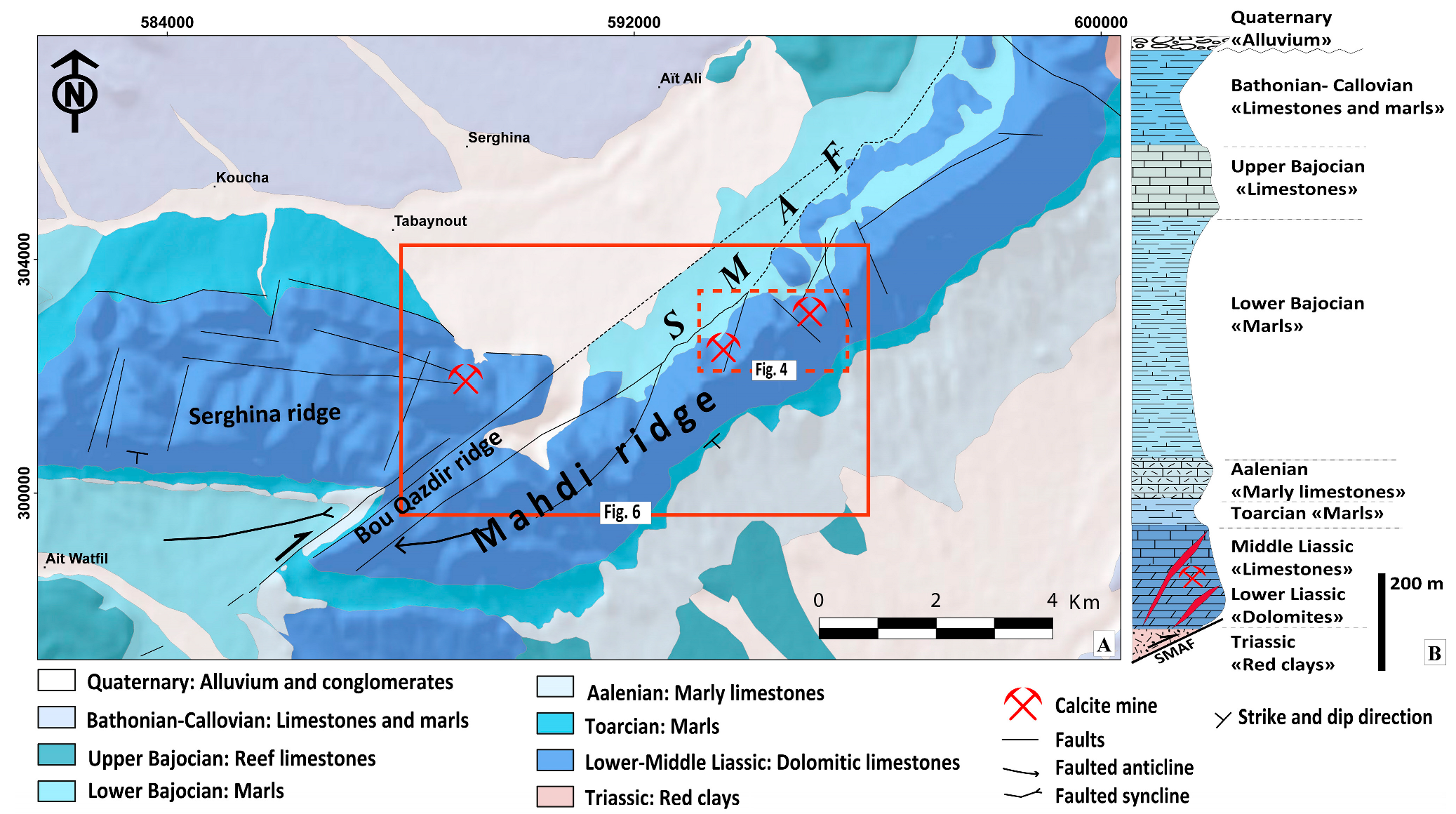
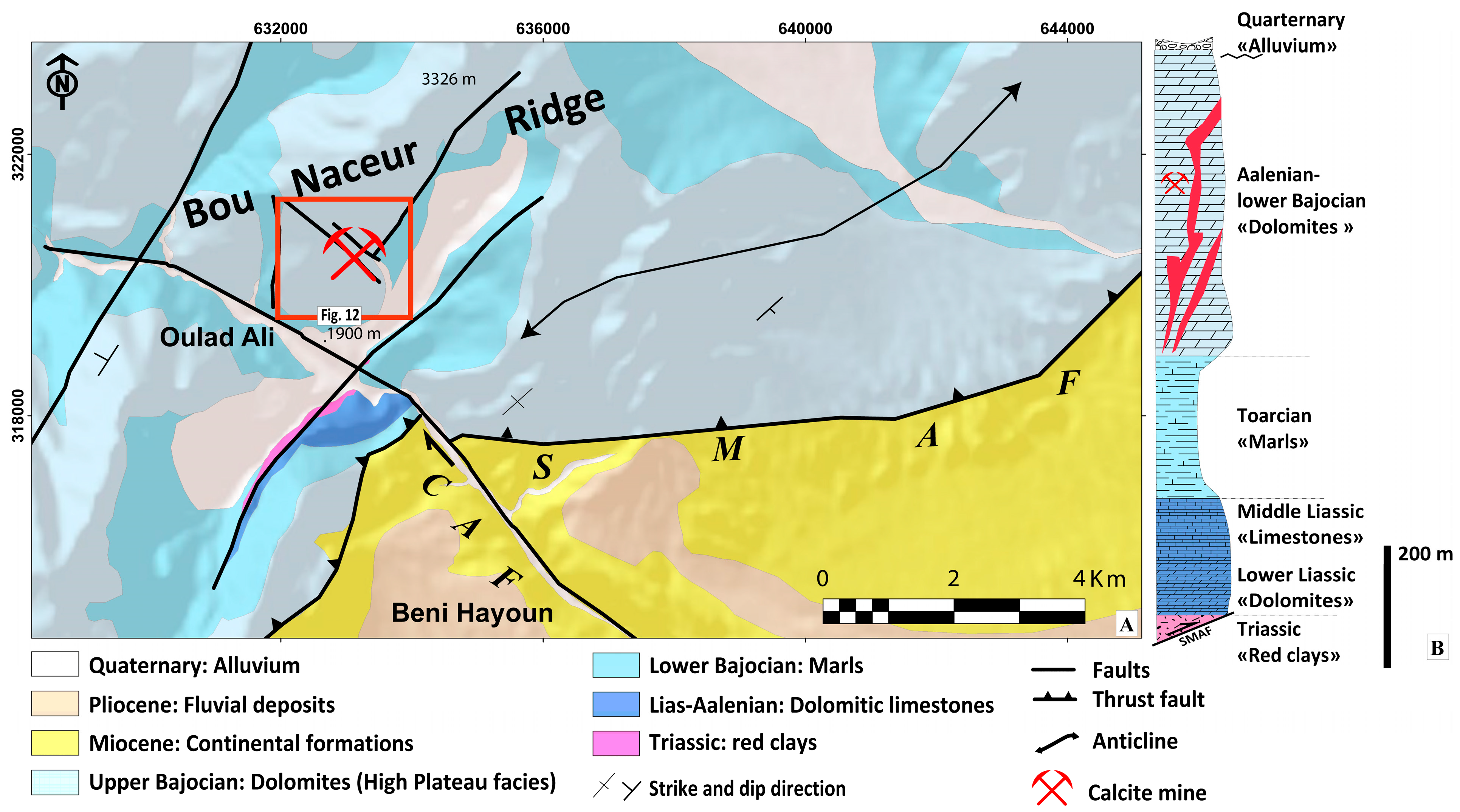
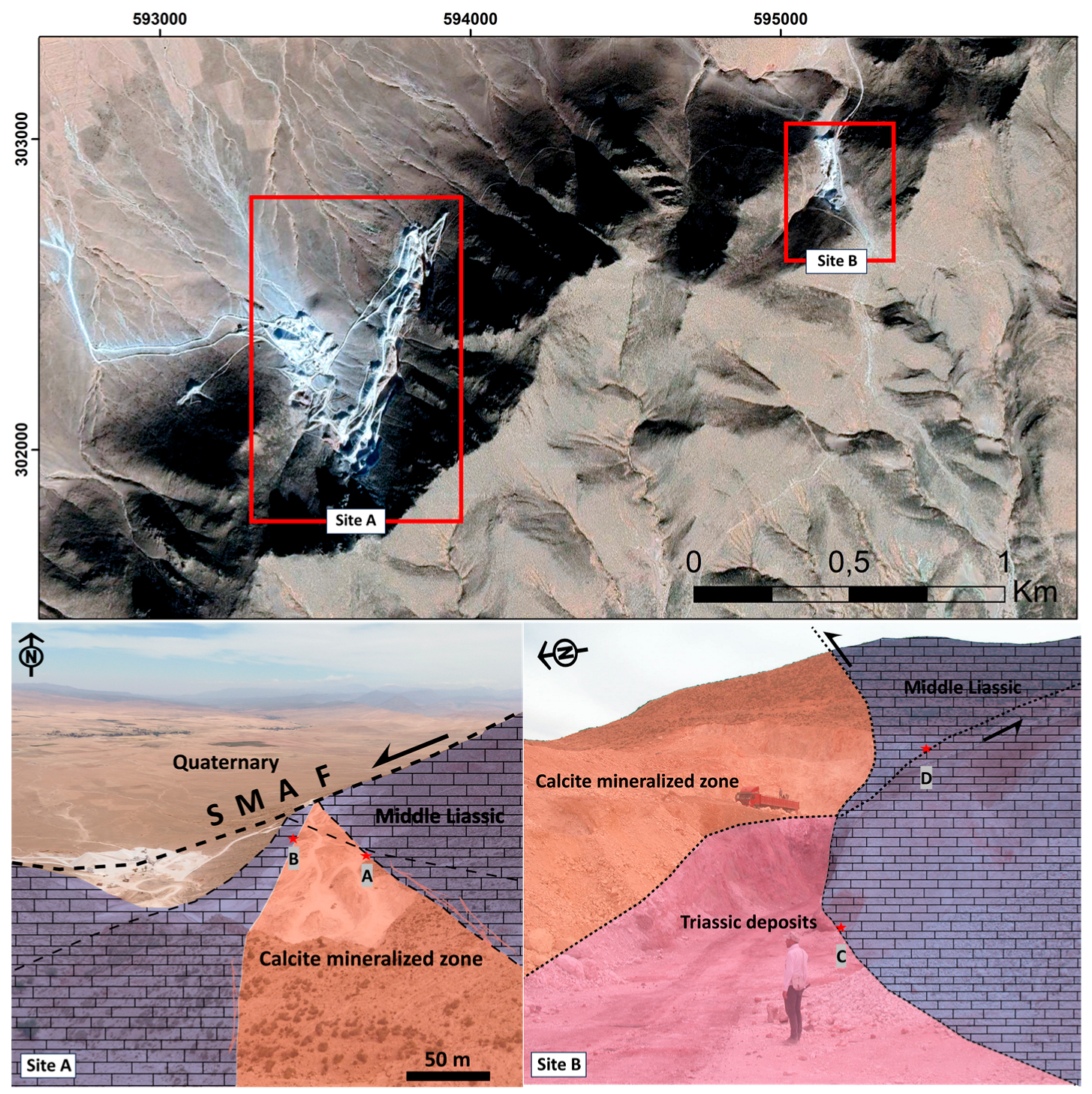
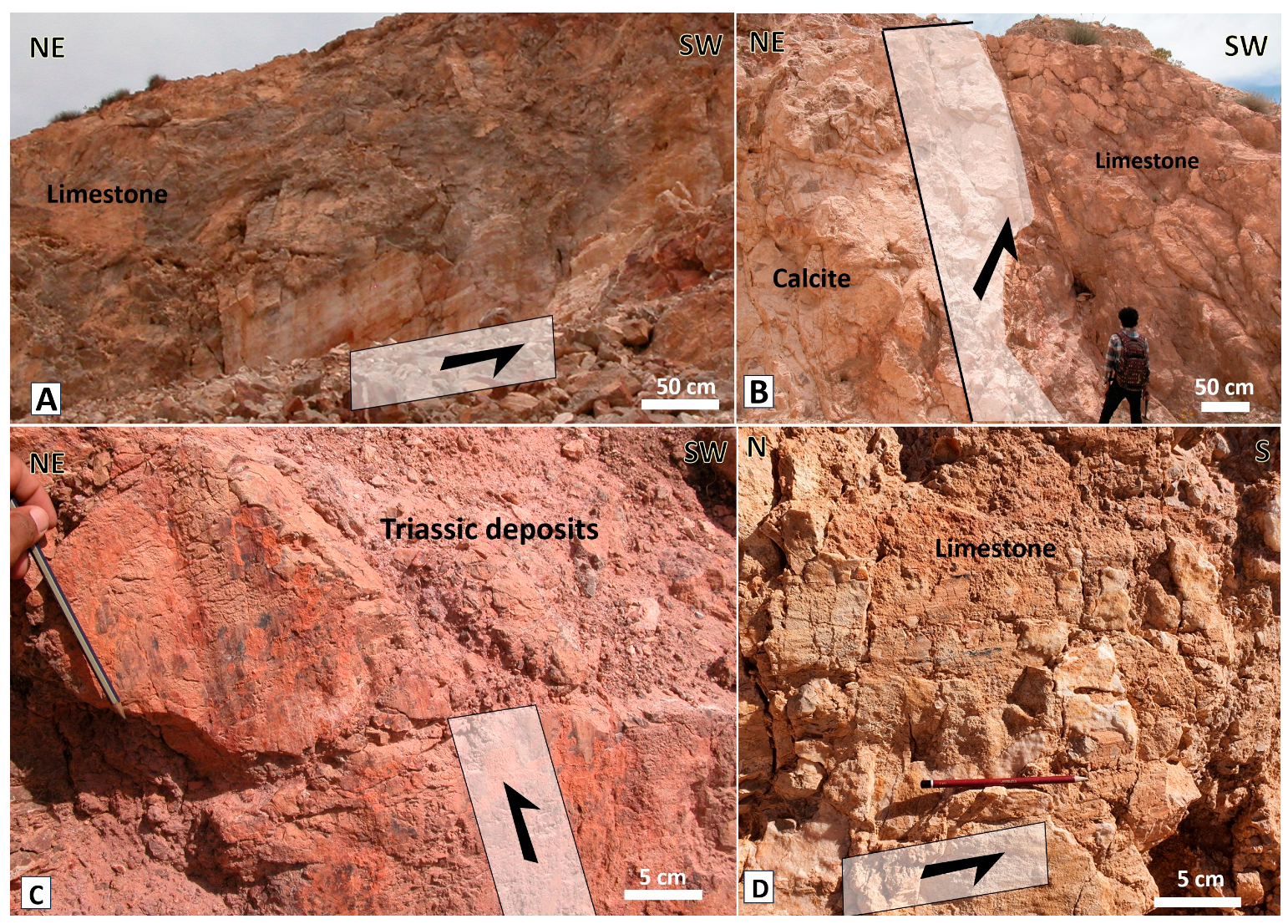
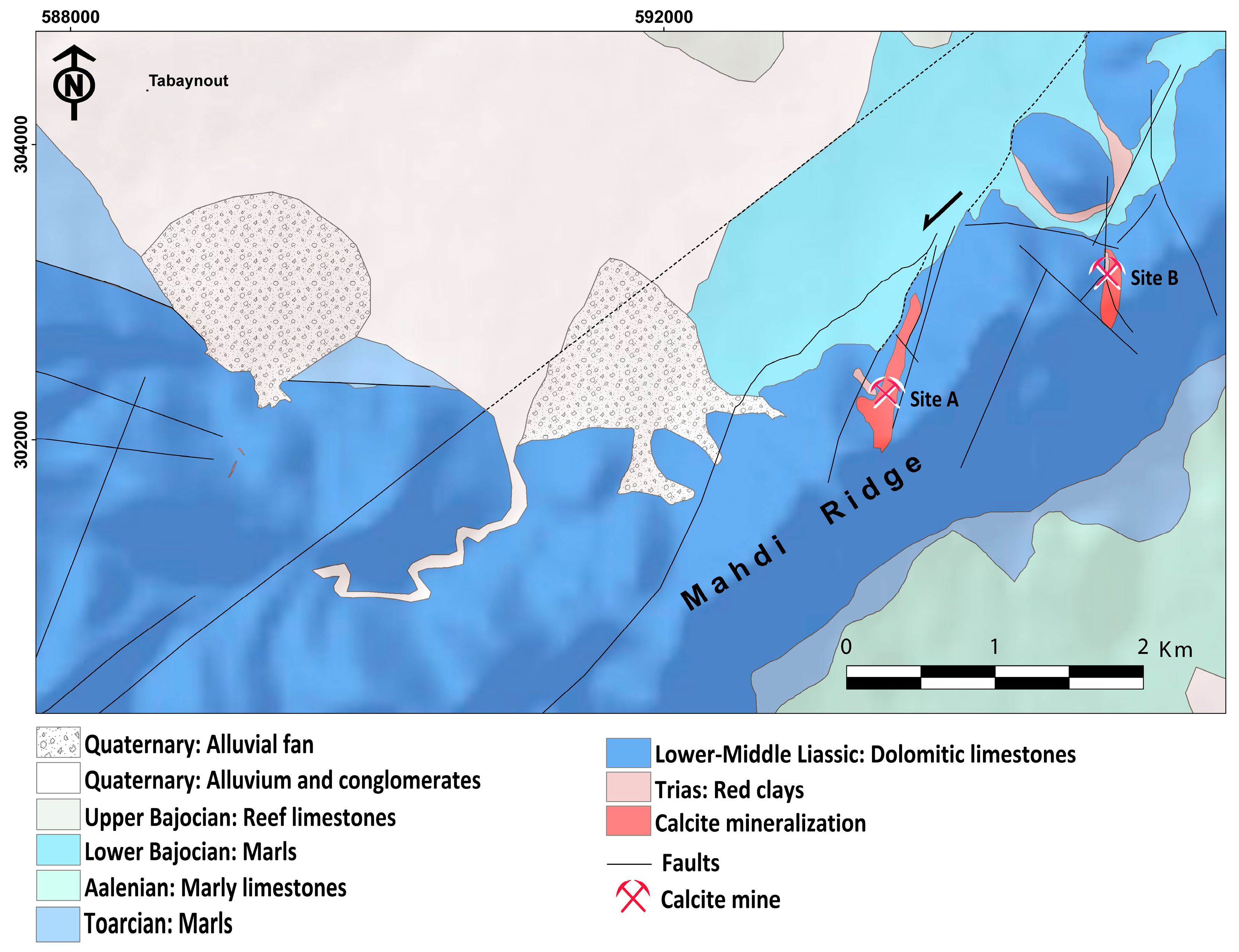
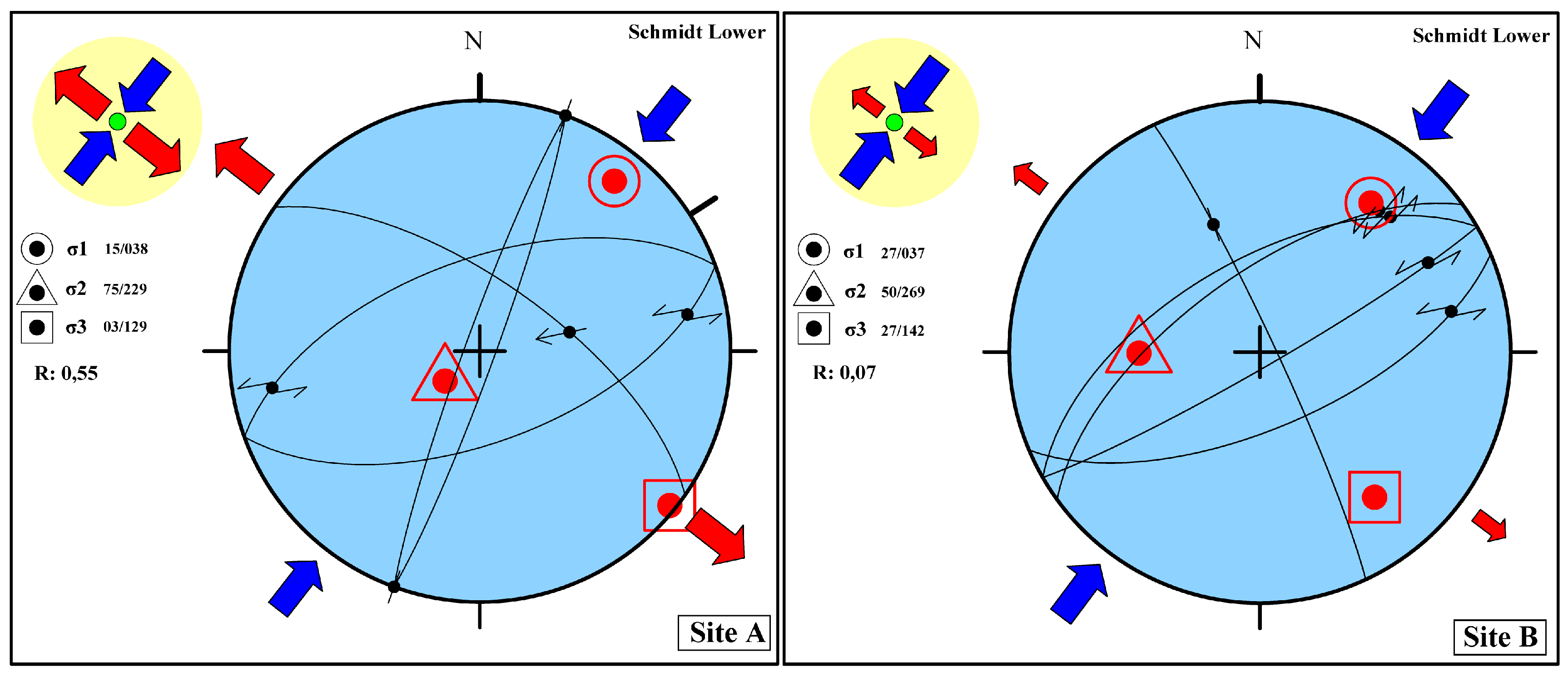
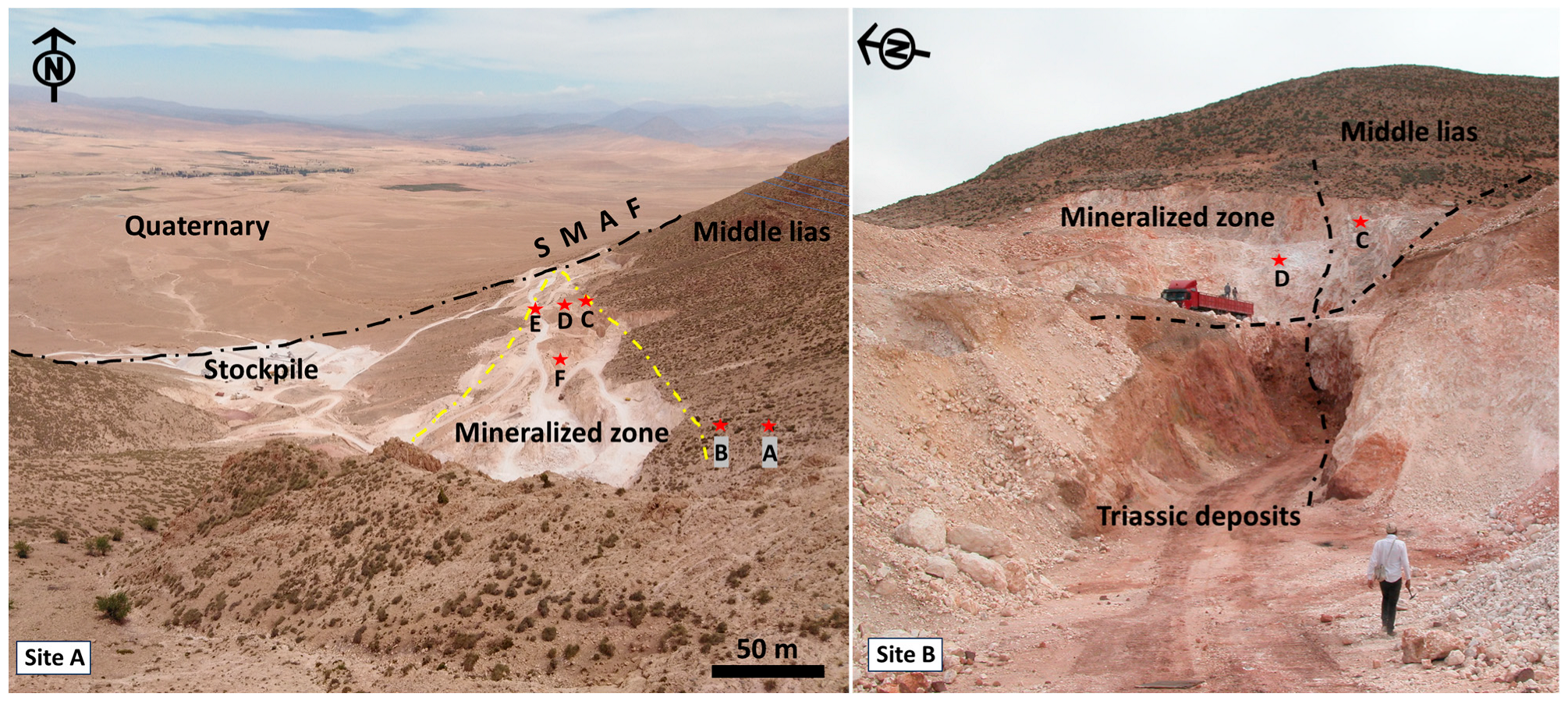

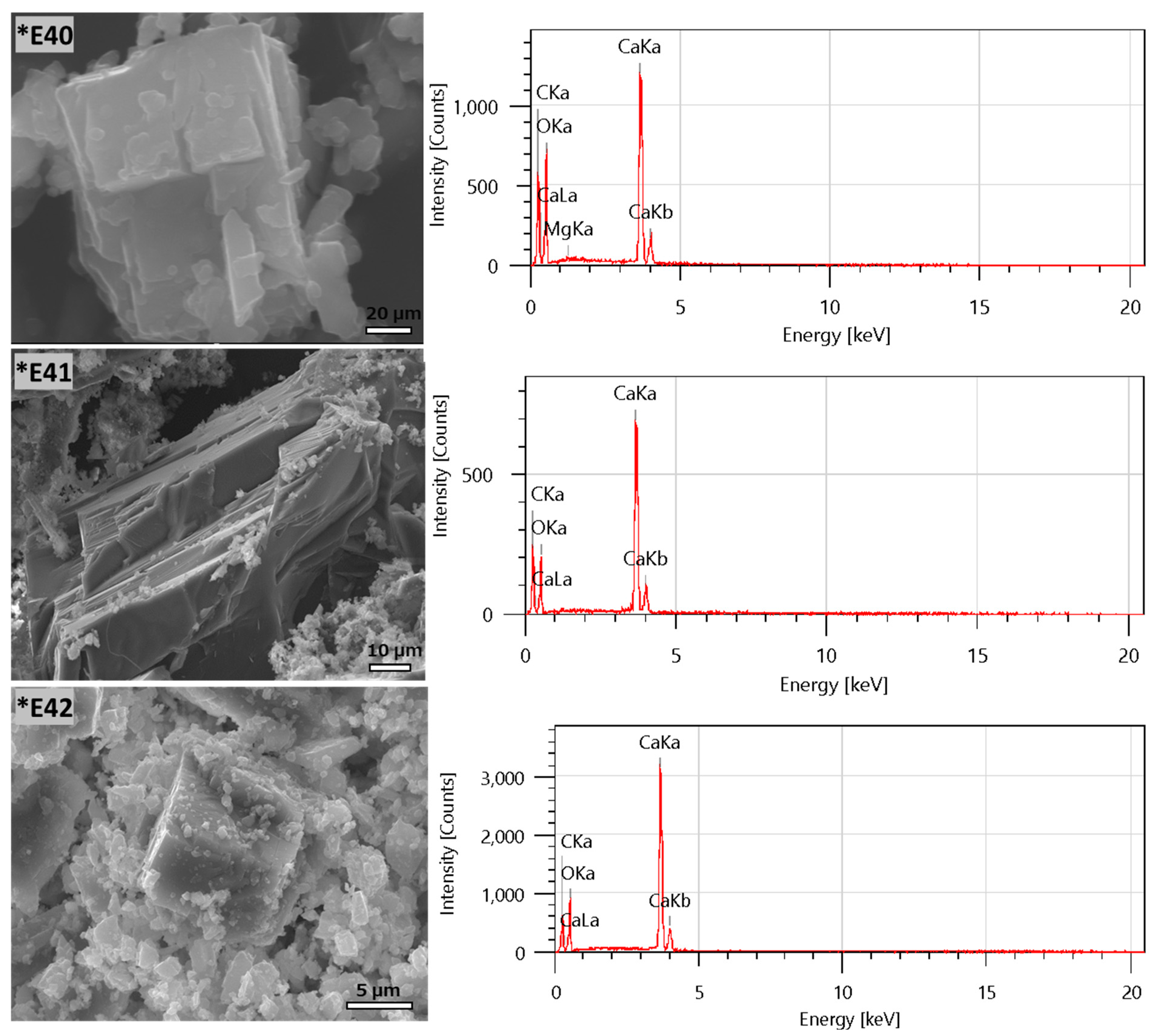
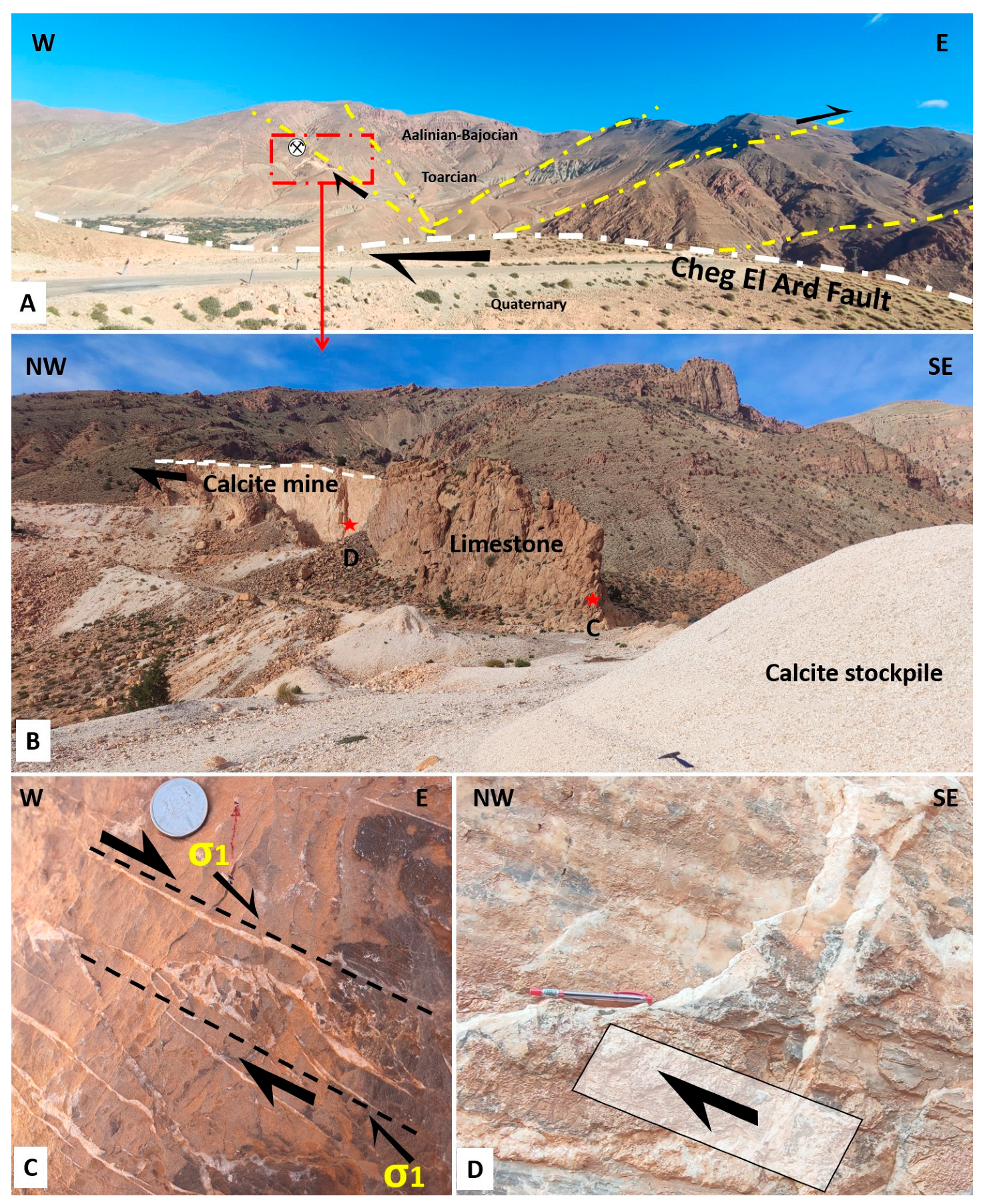
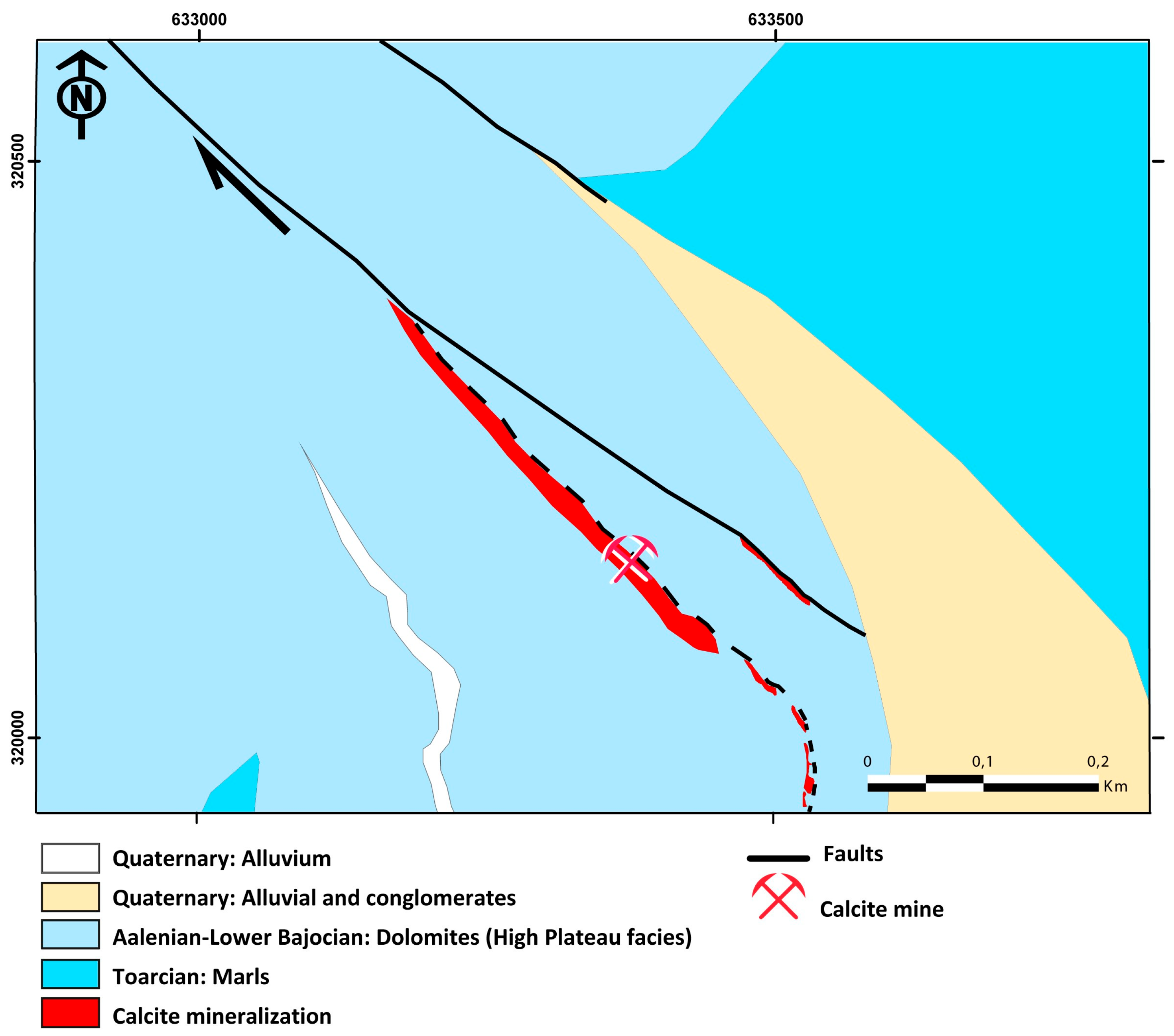


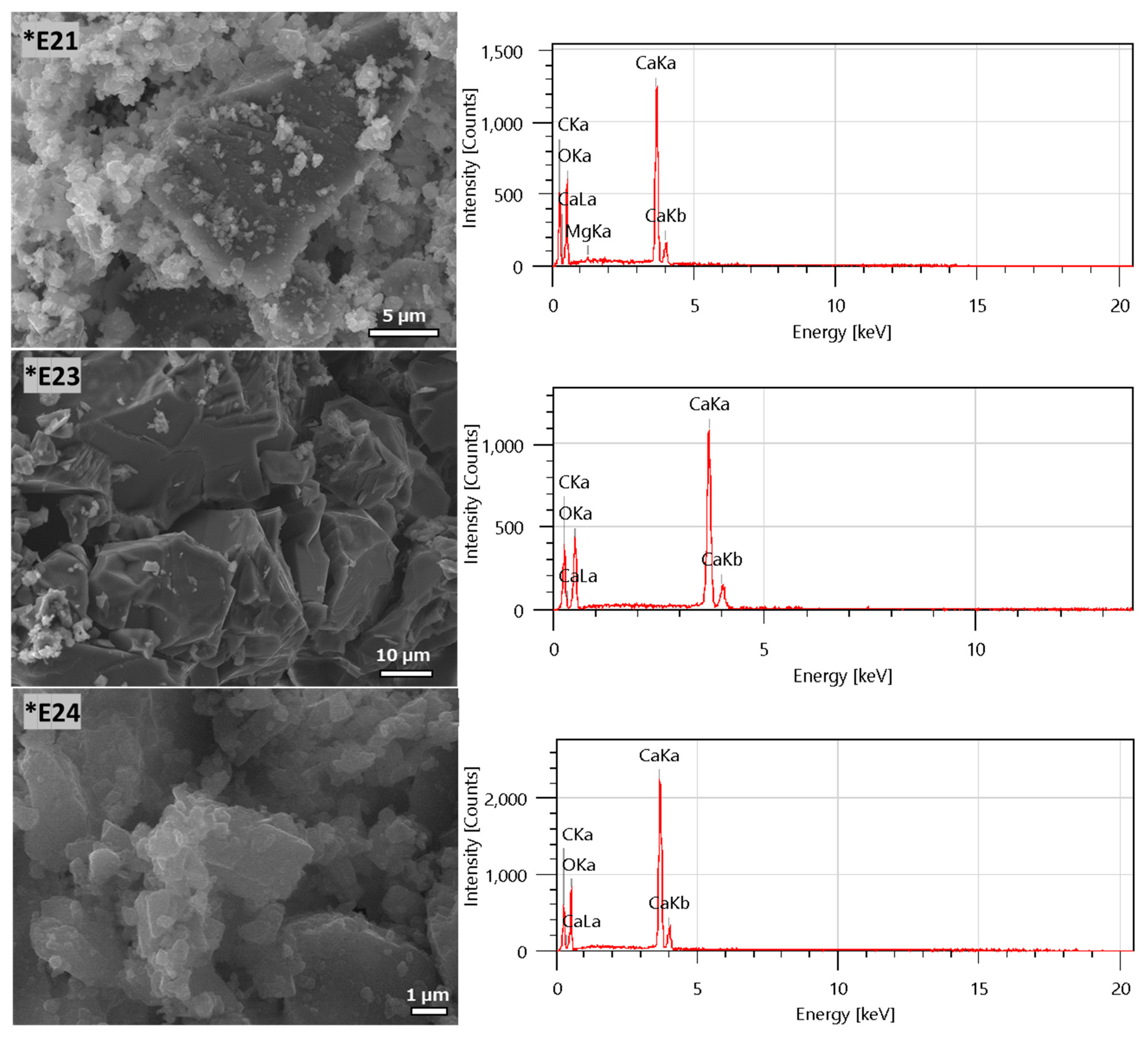
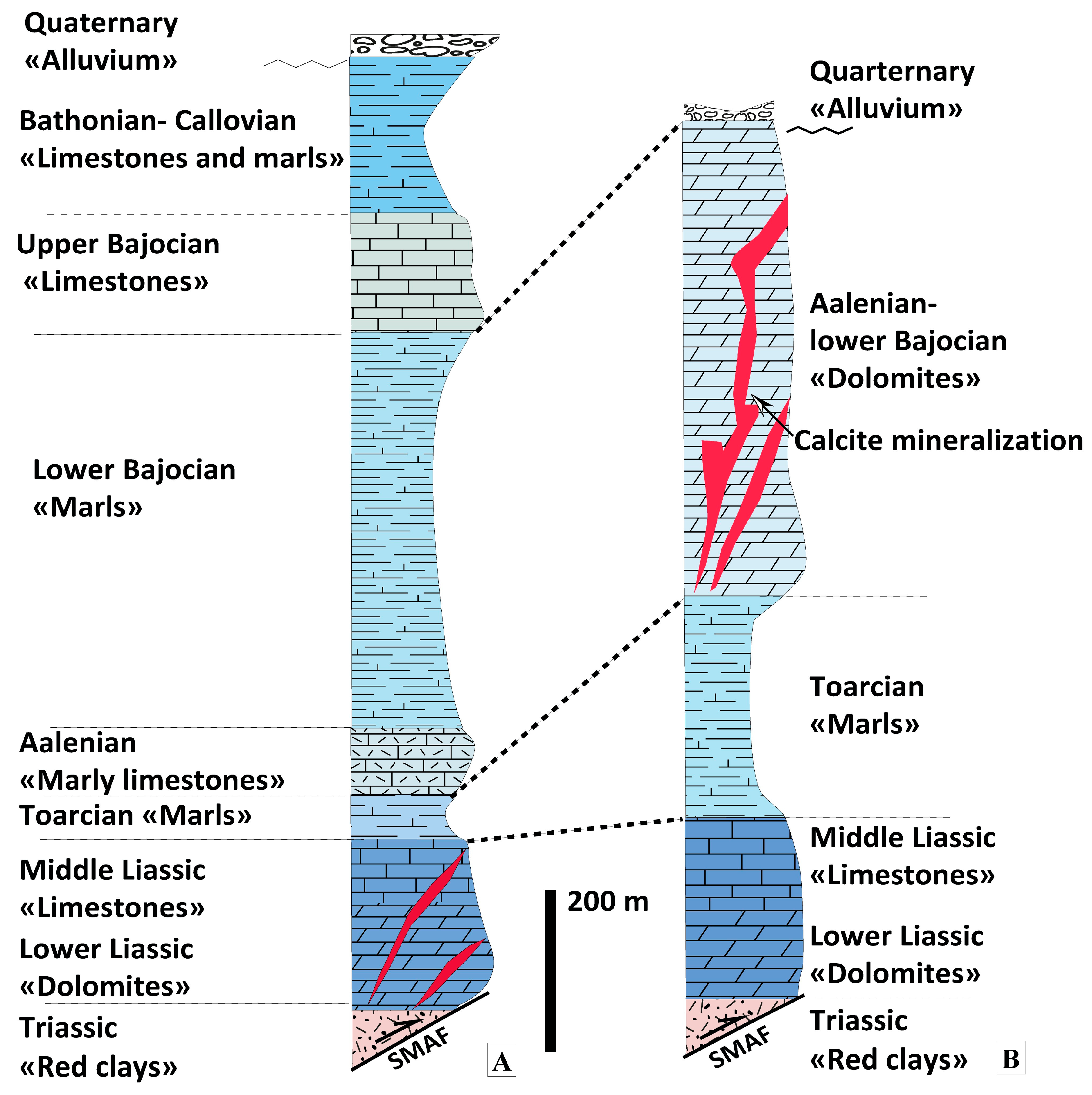
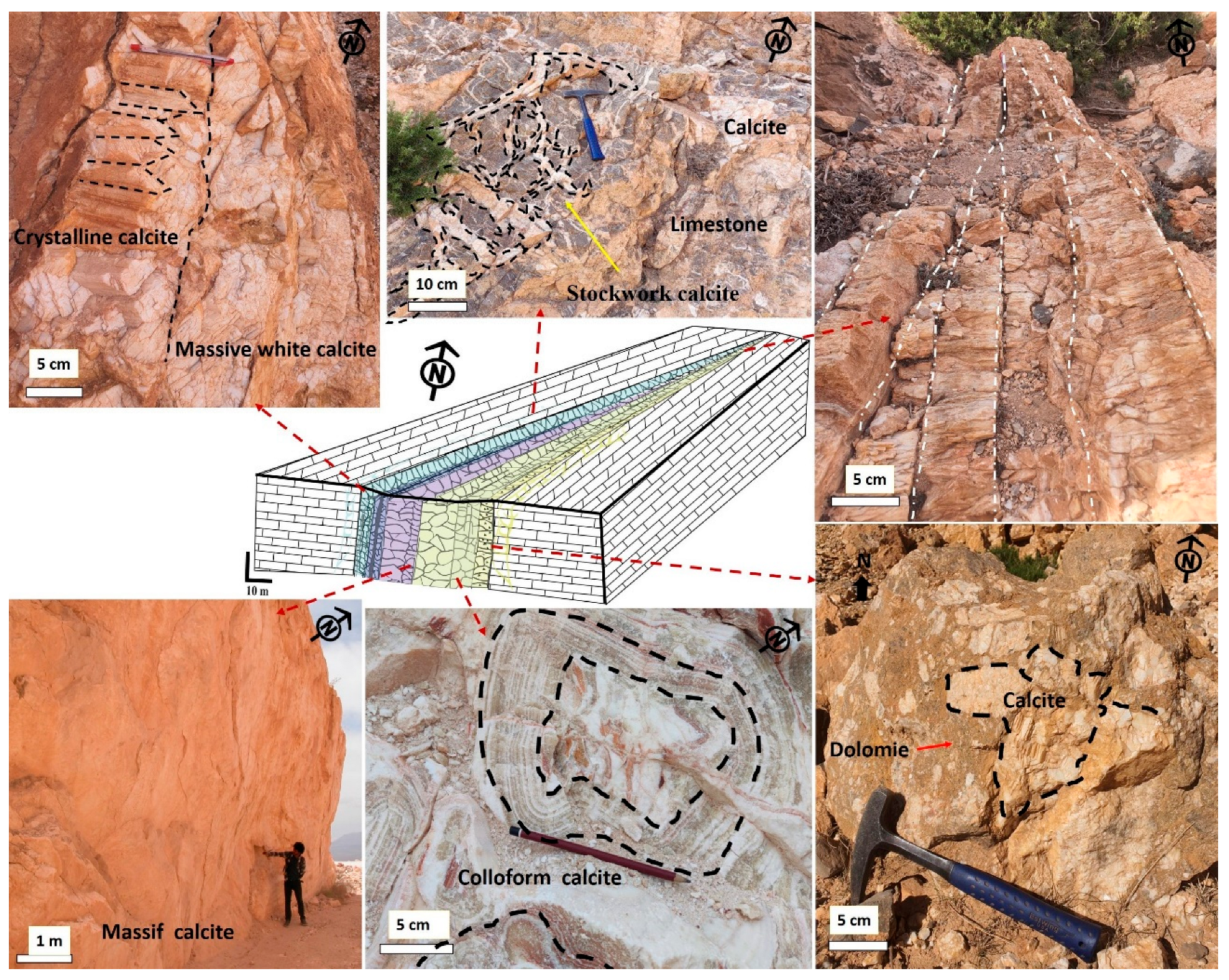
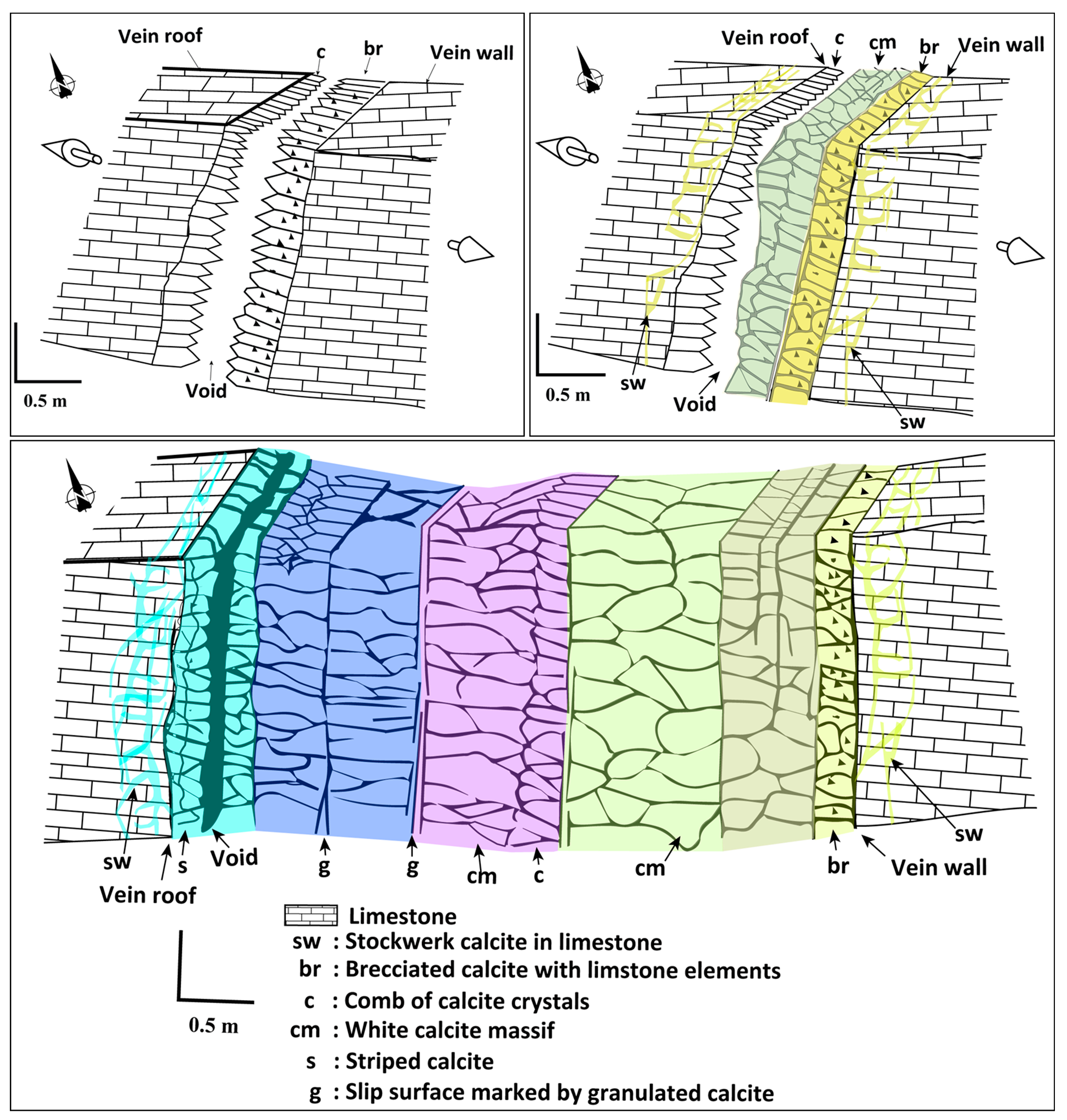
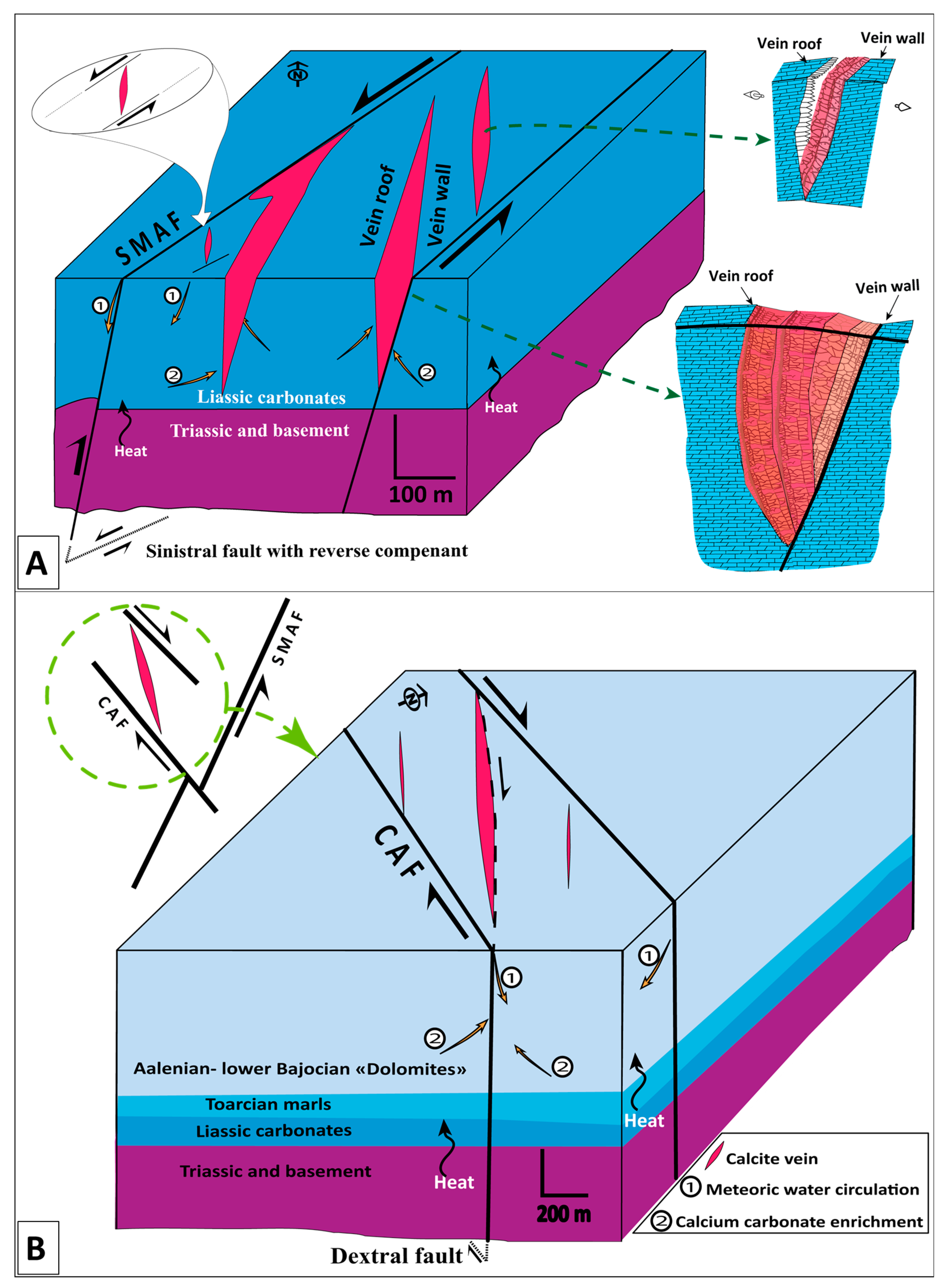
| Sector | Rosas Name | Latitude | Longitude | n | σ1 | σ2 | σ3 | R | α | Tectonic Regime |
|---|---|---|---|---|---|---|---|---|---|---|
| Mahdi Ridge | Mahdi Ridge (site A) | 33°18′58.13″ N | 4°23′34.19″ W | 7 | 15/038 | 75/229 | 03/129 | 0.55 | 2 | Sinistral strike–slip fault |
| Mahdi Ridge (site B) | 33°19′19.01″ N | 4°22′40.00″ W | 6 | 27/037 | 50/269 | 27/142 | 0.07 | 0.9 | Sinistral strike–slip fault |
| Element | Grade (%) |
|---|---|
| CaCO3 | 99.16 |
| Mgo | 0.53 |
| SiO2 | 0.11 |
| Fe (total) | 0.02 |
| Fire loss | 43.6 |
| Insoluble acid | 0.10 |
| Sector | Vein Name | Latitude | Longitude | N | σ1 | σ2 | σ3 | R | α | Tectonic Regime |
|---|---|---|---|---|---|---|---|---|---|---|
| Bou Naceur | Oulad Ali | 33°28′15.82″ N | 3°57′47.69″ W | 7 | 11/163 | 67/279 | 20/069 | 0.77 | 3.5 | Dextral strike–slip fault |
Disclaimer/Publisher’s Note: The statements, opinions and data contained in all publications are solely those of the individual author(s) and contributor(s) and not of MDPI and/or the editor(s). MDPI and/or the editor(s) disclaim responsibility for any injury to people or property resulting from any ideas, methods, instructions or products referred to in the content. |
© 2024 by the authors. Licensee MDPI, Basel, Switzerland. This article is an open access article distributed under the terms and conditions of the Creative Commons Attribution (CC BY) license (https://creativecommons.org/licenses/by/4.0/).
Share and Cite
Ait Ali, A.; Charroud, M.; Choukrad, J.; Ouahzizi, Y.; Si Mhamdi, H.; El Moutaouakkil, N.; Saoud, N.; Mechaqrane, A. Identification, Characterization, and Deposit Model of Calcite Mineralization in the Middle Atlas Belts, Morocco. Geosciences 2024, 14, 154. https://doi.org/10.3390/geosciences14060154
Ait Ali A, Charroud M, Choukrad J, Ouahzizi Y, Si Mhamdi H, El Moutaouakkil N, Saoud N, Mechaqrane A. Identification, Characterization, and Deposit Model of Calcite Mineralization in the Middle Atlas Belts, Morocco. Geosciences. 2024; 14(6):154. https://doi.org/10.3390/geosciences14060154
Chicago/Turabian StyleAit Ali, Abdelkhiar, Mohammed Charroud, Jaouad Choukrad, Youssef Ouahzizi, Hicham Si Mhamdi, Nacir El Moutaouakkil, Naoufal Saoud, and Abdellah Mechaqrane. 2024. "Identification, Characterization, and Deposit Model of Calcite Mineralization in the Middle Atlas Belts, Morocco" Geosciences 14, no. 6: 154. https://doi.org/10.3390/geosciences14060154
APA StyleAit Ali, A., Charroud, M., Choukrad, J., Ouahzizi, Y., Si Mhamdi, H., El Moutaouakkil, N., Saoud, N., & Mechaqrane, A. (2024). Identification, Characterization, and Deposit Model of Calcite Mineralization in the Middle Atlas Belts, Morocco. Geosciences, 14(6), 154. https://doi.org/10.3390/geosciences14060154









